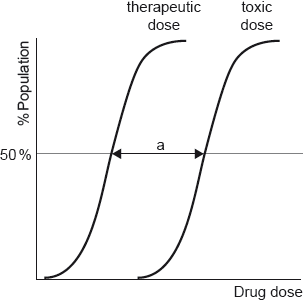| Date | May 2019 | Marks available | 2 | Reference code | 19M.3.hl.TZ2.21 |
| Level | HL | Paper | 3 | Time zone | TZ2 |
| Command term | Distinguish | Question number | 21 | Adapted from | N/A |
Question
Medicines and drugs are tested for effectiveness and safety.
Distinguish between therapeutic window and therapeutic index in humans.
Therapeutic window:
Therapeutic index:
Explain why diamorphine (heroin) is more potent than morphine using section 37 of the data booklet.
Markscheme
Therapeutic window:
range of dosage «over which a drug» provides the therapeutic/desired effect without causing adverse/toxic effects [✔]
Therapeutic index:
toxic dose of drug for 50 % of population divided by minimum effective dose for 50 % of population
OR
[✔]
Note: M1 may be scored from a correctly labelled diagram.
Do not accept reference to lethal dose used in therapeutic index in animal studies.
morphine has «two» hydroxyl groups AND diamorphine has «two» ester/ethanoate/acetate groups
OR
molecule of diamorphine is less polar than morphine
OR
groups in morphine are replaced with less polar/non-polar groups in diamorphine [✔]
«less polar molecules» cross the blood–brain barrier faster/more easily
OR
diamorphine is more soluble in non-polar environment of CNS/central nervous system than morphine [✔]
Note: Accept “alcohol/hydroxy” for “hydroxyl” but not “hydroxide”.
Accept “fats” for “lipid”.
Accept “heroin” for “diamorphine”.
Examiners report
Most candidates receive one mark for this question, mainly for the therapeutic window. Some candidates inverted the ratio as ED50/TD50 for therapeutic index.
This part was reasonably well answered with some very good answers.


